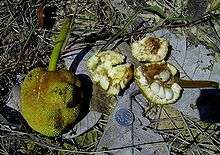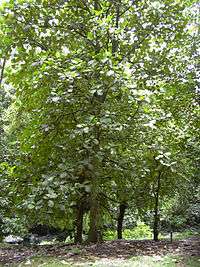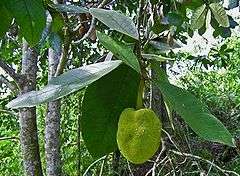Artocarpus odoratissimus
| Terap/Tarap/Marang | |
|---|---|
 | |
| Scientific classification | |
| Kingdom: | Plantae |
| Clade: | Angiosperms |
| Clade: | Eudicots |
| Clade: | Rosids |
| Order: | Rosales |
| Family: | Moraceae |
| Genus: | Artocarpus |
| Species: | A. odoratissimus |
| Binomial name | |
| Artocarpus odoratissimus | |
| Synonyms[1] | |
| |

Artocarpus odoratissimus, also called terap,marang, johey oak, green pedalai, madang, tarap, or timadang, is a tree in the mulberry and fig family Moraceae. It is native to Borneo, Palawan, and Mindanao Island, and is closely related to the jackfruit, cempedak, and breadfruit trees which all belong to the same genus, Artocarpus.
Description
Artocarpus odoratissimus is an evergreen tree growing to 25 metres (82 ft) tall. The leaves are 16–50 cm long and 11–28 cm broad, similar to the Breadfruit's, but are a little less lobed. Many trees lose the leaf lobing once mature.
Fruit
As indicated by the scientific name, the fruit has a strong scent, and is considered superior in flavour to both jackfruit and cempedak. The scent reminds some of the durian but is not so intense, and is in the thick skin and not the fruit pulp. The taste has hints of a mild creamy, almost juicy banana, and is best when not allowed to ripen thoroughly on the tree. Those ripened on the tree turn a more brownish color and will eventually fall to the ground and easily split open.

The appearance of the fruit can be regarded as an intermediate shape between the jackfruit and the breadfruit. It is round to oblong, 15–20 cm long and 13 cm broad, and weighing about 1 kg. The thick rind is covered with soft, broad spines. They become hard and brittle as the fruit matures. When fully mature the expanding arils stretch the outer rind which often appears lumpy, especially if not all seeds were pollinated. The fruit does not fall to the ground until over-ripe. It may be harvested when full size but still firm, and left to ripen until soft. Fruits change colour to greenish yellow when ripe. The ripe fruit is opened by cutting the rind around, twisting and gently pulling. If overripe they are simply pulled apart. The interior of the fruit is somewhat similar to the jackfruit's, but the color is white and the flesh is usually softer. The core is relatively large, but there are far fewer "rags" and less non-edible parts. Arils are white and the size of a grape, each containing a 15 × 8 mm seed. Once opened, the fruit should be consumed quickly (in a few hours), as it loses flavour rapidly and fruit oxidizes. The seeds are also edible after boiling or roasting.
Cultivation
Artocarpus odoratissimus is cultivated for its fruit in Brunei, Indonesia, Malaysia, the Philippines, southern Thailand and India Tripura. The species is largely grown for local consumption; the short shelf-life of the fruit limits its wider use.
The tree is not cold tolerant (as is the breadfruit). It can grow between latitude 15° north and south, and in coastal regions where temperatures never stay under 7 °C.
Similar fruits
The fruits of Artocarpus sericicarpus (known as the pedalai, or buah tarap) and Artocarpus sarawakensis (pingan or mountain tarap) are very similar to, and often confused with A. odoratissimus. Both these species are native to the same areas. However, they are still distinguishable based on their appearances when ripe. Artocarpus sericicarpus has hairs, like a large rambutan, and ripens red. Artocarpus sarawakensis is even trickier, because it is the shape of A. odoratissimus, and it is orange. It has smaller kernel sections.
Uses of tarap wastes
There are many uses of the leftover tarap peels, stem axis and seeds. The tarap peels were reported as useful material for the removal of colouring agents (such as crystal violet,[2] methyl violet 2B and methylene blue [3]) from dye wastewater. The tarap stem axis were reported to be used in the removal of Cd (II) and Cu(II).[4]
References
- ↑ The Plant List: A Working List of All Plant Species, retrieved 1 October 2015
- ↑ Lim, Linda B. L.; Priyantha, Namal; Zehra, Tasneem; Then, Cheow Wei; Chan, Chin Mei (2016-05-08). "Adsorption of crystal violet dye from aqueous solution onto chemically treated Artocarpus odoratissimus skin: equilibrium, thermodynamics, and kinetics studies". Desalination and Water Treatment. 57 (22): 10246–10260. doi:10.1080/19443994.2015.1033474. ISSN 1944-3994.
- ↑ Lim, Linda B. L.; Priyantha, Namal; Ing, Chieng Hei; Dahri, Muhd Khairud; Tennakoon, D. T. B.; Zehra, Tasneem; Suklueng, Montri (2015-01-23). "Artocarpus odoratissimus skin as a potential low-cost biosorbent for the removal of methylene blue and methyl violet 2B". Desalination and Water Treatment. 53 (4): 964–975. doi:10.1080/19443994.2013.852136. ISSN 1944-3994.
- ↑ Lim, Linda B. L.; Priyantha, Namal; Tennakoon, D. T. B.; Dahri, Muhd Khairud (2012-03-06). "Biosorption of cadmium(II) and copper(II) ions from aqueous solution by core of Artocarpus odoratissimus". Environmental Science and Pollution Research. 19 (8): 3250–3256. doi:10.1007/s11356-012-0831-2. ISSN 0944-1344.